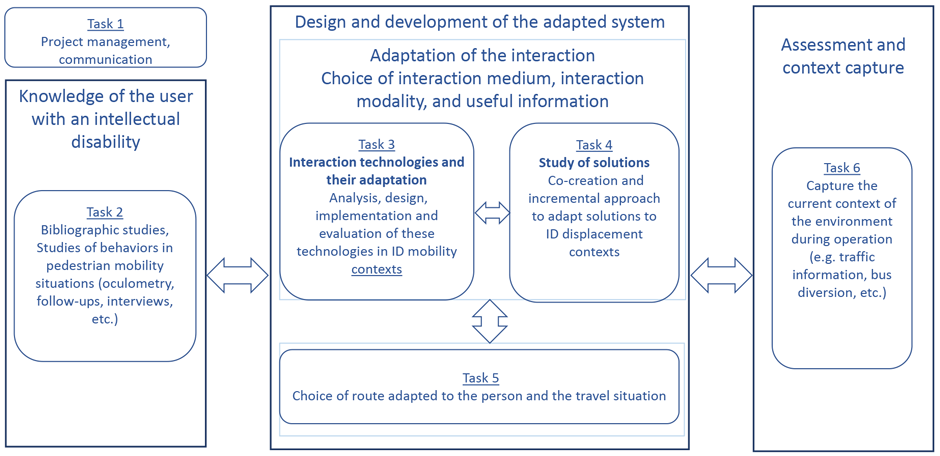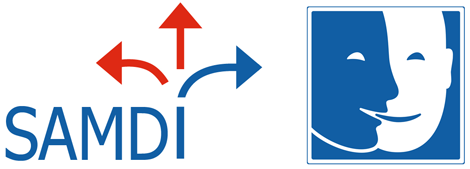Scientific and technical program, organization of the project
The SAMDI project is planned on 36 months. The scientific program is composed of 6 tasks corresponding to the 5 tasks shown in Figure 1 plus the project coordination task.

Figure 1 : project structure
Task 1 (T0 - T0+36) is the coordination of the project, from the beginning to the end. It is ensured by the LAMIH. The content and deliverables expected from this task correspond to the description of the coordinator's role.
Task 2 (T0 - T0+6) aims to provide knowledge on the characteristics of people with intellectual disabilities, on their navigation skills but also on their travel behaviors based on scientific literature, interviews with users and professionals working with them, travel analyses (tracking, photovoice, etc.), oculometry (technology allowing the identification of visual information used by people) and experiments in real or virtual environment. The PSITEC laboratory will be responsible for this task, in interaction with the LAMIH and the UDAPEI of the North. A report (L1) is expected at the end of this task.
Task 3 (T0+4 - T0+ 24) aims to propose technological solutions adapted to the context by promoting human-machine interactions adapted to users. It is iterative and incremental, in an agile approach, focused on the user and his/her specific needs. This task depends on task 2. It is under the responsibility of LAMIH, in close relation with PSITEC and UDAPEI du Nord. It will be the role of Urban Labs Technologies to verify the compatibility of the proposals with the feasibility of integration in the final tool. This task foresees a deliverable (L2) at T0+10 integrating the interaction proposals and at T0+24 (L3) on the evaluation of one of the selected and developed solutions.
Task 4 (T0+4 - T0+24) consists of adopting a co-creation approach in order to study mobility solutions adapted to the target audience. This task is complementary to task 3. PSITEC is responsible for the task, in strong collaboration with LAMIH for technical aspects and feedback, as well as with UDAPEI du Nord and partner associations that will be strongly involved in the participative approach. This task foresees a deliverable (L4) at T0+10 showing the progress of the co-creation method and (L5) at T0+24 reporting on the evaluations of the retained and prototyped solutions.
Task 5 (T0+20 - T0+26) concerns the choice of route. It is an extension to the existing application, named Jericoapp, which should allow to take into account the specificities of the targeted public. Indeed, to date Urban Labs Techologies, which is responsible for the task, does not have the knowledge to develop this part of the project. It will therefore use the results of tasks 2 and 4 and will also involve PSITEC and LAMIH in order to ensure compatibility with the human-machine interface. The deliverable (L6 to T0+26) consists in providing a new version of the application.
Finally, task 6 (T0+26 - T0+36) is also carried out by Urban Labs Technologies but its objective is to provide contextual information about a person or to highlight the strategies used by a group. We plan to use the data to determine the user's profile and thus implement the adaptation (task 3). It is therefore in relation with both laboratories LAMIH and PSITEC, as well as with the UDAPEI of the North and the partner associations.
Valuation and promotion of the project
We note 3 axes of Valuation of the project:
-
- The first axis aims at publications, conferences and scientific journals, at the national and international levels of the scientific advances related to this project.
- The second axis aims to promote the project to the general public. The target public being partly actor of the project, broadcasts on social networks of the demonstrators will be considered for a large diffusion.
- Finally, days will be organized with the help of the PRIMOH pole and the MESHS in order to communicate the results of this research.
